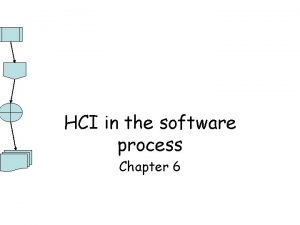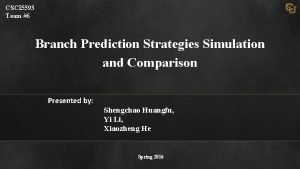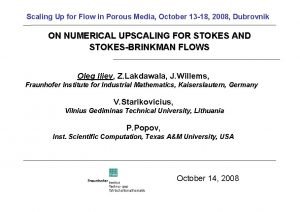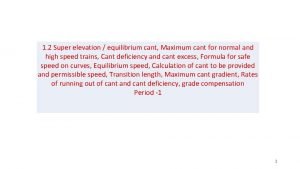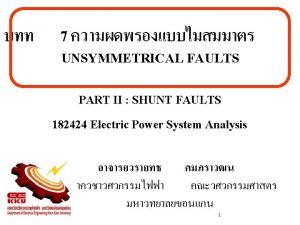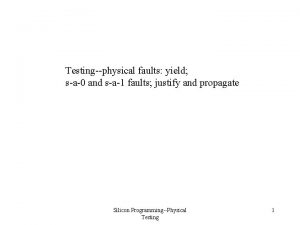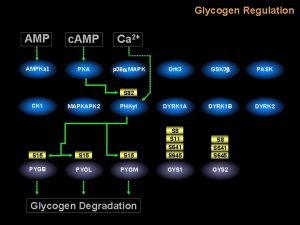AMP cant simulate SMP with Crash Faults AMP



















- Slides: 19

AMP can’t simulate SMP with Crash Faults AMP: Assume (in contrast) that there exists a simulation. A simulating algorithm, �� , needs to provide, for each AMP run, a sequence of outputs that algorithm �� outputs in a possible SMP run We proved that no algorithm in AMP can simulate algorithm �� We played with similarity of runs, by introducing the same run (run X) to the nodes in different scenarios The core idea – in AMP a node can’t timeout.

A State Machine in TSM outputs Inputs / messages state messages H The sequence of messages and outputs depends solely on 1. the initial state and initial input 2. the sequence of messages and inputs it receives 3. hardware clock readings

The Timed Message Passing model (TMP) - Each network node has a local hardware clock H - Each hardware clocks ’follows’ real-time - Clocks may drift apart, but there is a bound �� such that - How to model H? A node can access it via get. H() Events can be tagged by local time A node can measure time span A node can set up a timeout Uncerainty: local hardware clock drift

The Timed Message Passing model (TMP) - Each network node has a local hardware clock H - Each hardware clocks ’follows’ real-time - Clocks may drift apart, but there is a bound �� such that - Uncerainty: local hardware clock drift Assume v is the fastest clock and w the slowest From the equation above over a real time period �� the difference between the values of the hardware clocks of v and w may increase by �� (�� -1)

The Timed Message Passing model (TMP) - Each network node has a local hardware clock H - - - There is a bound d on end-to-end message transmission and processing time A Node can now identify missing messages Calculate a local logical time L, so we can bound the difference (skew) among logical clocks. get. L() A Node can compare its clock to its neighbors’ Uncertainties: hardware clock drift, and message transmission time

Sender/Receiver Synchronization Assume a node w has acccess to external time source Other nodes have local hardware clock and the end to end message transmission time, d, is known EX 1: design an algorithm to synchronize the clocks of the neighbors of w

7

Sender/Receiver Synchronization • Round-Trip Time (RTT) based synchronization t w 2 Time according to w t 1 3 Answer from w Request from v v t Time according to v t 4 • Receiver synchronizes to the sender‘s clock • Propagation delay (<d) and clock offset can be calculated

MAX algorithm Assume – the logical clock Lv is updated in the background at the rate of the hardware clock. The algorithm is invoked upon these events: : wakeup, receiving a message, or on timeout 1. Wakeup: Lv: =Hv (performed only on wakeup) 2. If received l’ and l’> Lv Lv : =l’ – update logical clock 3. If Lv=k. T then send <k. T> to neighbors (performed at the same clock time as line 2) Notice: updating the logical clock is done by adding the difference (l’ – Lv) to Lv – or resetting Lv

MAX algorithm Assume – the logical clock Lv is updated in the background at the rate of the hardware clock. The algorithm is invoked upon these events: : wakeup, receiving a message, or on timeout 1. Wakeup: Lv: =Hv (performed only on wakeup) 2. If received l’ and l’> Lv Lv : =l’ – update logical clock 3. If Lv=k. T then send <k. T> to neighbors Notice: after updating the clock in Line 2 the node always execute Line 3 since the updated clock is always a multiple of T

MAX algorithm 1. Wakeup: Lv: =Hv (performed only on wakeup) 2. If received l’ and l’> Lv Lv : =l’ – update logical clock 3. If Lv=k. T then send <k. T> to neighbors Assume: La is the largest clock (< k’T) La Lb Lc a b c When La=k’T: 1) a sends to b 2) b updates and send to c (if not sent before) 3) c updates

MAX algorithm 1. Wakeup: Lv: =Hv (performed only on wakeup) 2. If received l’ and l’> Lv Lv : =l’ – update logical clock 3. If Lv=k. T then send <k. T> to neighbors Assume: Ha is the largest hardware clock (< k’T) La a At time T Lb d b Lc d By time T �� c

MAX algorithm 1. Wakeup: Lv: =Hv (performed only on wakeup) 2. If received l’ and l’> Lv Lv : =l’ – update logical clock 3. If Lv=k. T then send <k. T> to neighbors Assume: Ha is the largest hardware clock (< k’T) La a Lb d b by time T �� by T �� +d Lc d c by T �� +Dd by T �� +2 d By time T �� +2 d the 3 logical clocks are larger than k’T

MAX algorithm 1. Wakeup: Lv: =Hv (performed only on wakeup) 2. If received l’ and l’> Lv Lv : =l’ – update logical clock 3. If Lv=k. T then send <k. T> to neighbors by time k. T �� La Lb d a Lc d b c by k. T �� +d by k. T �� +Dd By time k. T �� +Dd all logical clocks are ≥ (k-1+k’)T Observe that after the 1 st update, updates are by at most T

MAX algorithm – maximum clock diff La Lb La t 1 T L’ �� d La(t 4) – Lb(t 4) ? d Lc d t 2 a t 4 Lb(t 4) = Lb(t 2) + L= La(t 1) + L L t 3 Lb b c La(t 4) = La(t 1) + L’ + �� d La(t 4) - Lb(t 4) ≤ L’ - L+ �� d Observe that after the 1 st update, updates are by at most T

MAX algorithm – maximum clock diff La Lb La t 1 T L’ �� d La(t 4) – Lb(t 4) ? d Lc d t 2 a t 4 Lb(t 4) = Lb(t 2) + L= La(t 1) + L L t 3 Lb b c La(t 4) = La(t 1) + L’ + �� d La(t 4) - Lb(t 4) ≤ L’ - L+ �� d La(t 4) - Lb(t 4) ≤ T(�� -1) + �� d RECALL: the difference between the values of the hardware clocks of v and w may increase by �� (�� -1)

MAX algorithm – maximum clock diff La Lb La t 1 L’ T �� d La(t 4) – Lb(t 4) ? d Lc d t 2 a t 4 Lb(t 4) = Lb(t 2) + L= La(t 1) + L L t 3 Lb b c La(t 4) = La(t 1) + L’ + �� d La(t 4) - Lb(t 4) ≤ L’ - L+ �� d La(t 4) - Lb(t 4) ≤ T(�� -1) + �� d La(t 4) - Lx(t 4) ≤ T(�� -1) + �� d. D

MAX algorithm Assume – the logical clock Lv is updated in the background at the rate of the hardware clock. The algorithm is invoked upon these events: : wakeup, receiving a message, or on timeout 1. Wakeup: Lv: =Hv (performed only on wakeup) 2. If received l’ and l’> Lv Lv : =l’ – update logical clock 3. If Lv=k. T then send <k. T> to neighbors

MAX algorithm – First Synchronization La Lb t 0 T t 3 d t 0 L La(t 4) – Lb(t 4) ? t 4 La(t 0) - Lb(t 0) = H increase by �� (�� -1) La(t 4) - Lb(t 4) ≤ (T+d)(�� -1) + H La(t 4) - Lx(t 4) ≤ (T+d. D)(�� -1) + H
 You can t improve what you don t measure
You can t improve what you don t measure If you can't measure it it doesn't exist quote
If you can't measure it it doesn't exist quote Ideal and practical characteristics of op-amp pdf
Ideal and practical characteristics of op-amp pdf Simulate or animate some features of intended system
Simulate or animate some features of intended system Simulate
Simulate Usability specification in hci
Usability specification in hci Signal simulator tutorial
Signal simulator tutorial Simulate oled upscaling
Simulate oled upscaling Fluke 789 loop power
Fluke 789 loop power Cant cove base
Cant cove base Rob cant freshfields
Rob cant freshfields If you cannot measure it you cannot manage it
If you cannot measure it you cannot manage it Rail cant
Rail cant Eric cant
Eric cant Close your eyes imagine that you are the protagonist
Close your eyes imagine that you are the protagonist Parapet wall concrete
Parapet wall concrete If you can t beat them join them
If you can t beat them join them Equilibrium cant in railway
Equilibrium cant in railway I cant count
I cant count Favourite cars
Favourite cars



